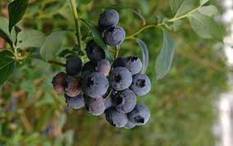BLUEBERRIES

Blueberries are an easy-to-grow super food. They make good plants for containers so you can get a reasonable crop whatever the size of your garden.
About blueberries
Blueberries, Vaccinium corybosum, taste delicious whether eaten fresh or cooked. The bushes can be evergreen or deciduous and usually grow to about 1.5m high. They do well in pots and you can get a reasonable crop whatever the size of your garden.
What to do
Soil preparation
- Blueberries require light, free-draining acidic soils, with plenty of rich, organic matter if they’re to thrive. The soil should have a lower pH of between 4 and 5.5, similar to the requirements of rhododendrons and camellias. It’s possible to lower the pH levels of your soil with sulphur chips or dust. However, they’ll need to be added three weeks before planting to take effect.
- Monitor the soil’s pH every few years, because it may be necessary to add acid. If you don’t have suitable soil, simply grow blueberries in a pot containing ericaceous compost, giving the plants a high potash feed (such as tomato feed) occasionally during the growing season.
How to plant
- Plant two different varieties of blueberries to ensure cross-pollination. A single blueberry plant will produce fruit, but the yields will be higher and the fruits bigger if more than one plant is grown. They require a position in full sun or light shade.
- Plant blueberries in autumn or winter leaving about 1.5m (5ft) gaps between them and mulch with a layer of acidic peat, wood chippings or pine needles. Water in well using rainwater rather than tap water if possible. Tap water contains lime which renders the soil less acidic over time.
Aftercare
- Use nets to protect plants from birds in the fruiting season.
- Mulch each spring. Chipped up pine tree or pine needles are ideal mulches to place around plants because they’re fairly acidic.
- Water plants regularly. They require water from when their buds begin to show in spring until their leaves fall in autumn. Again, remember to use rainwater.
Harvesting and storage
- Blueberry fruits, which are borne in clusters, ripen at different times. This could mean having to regularly pick the same bush over the ripening period.
- Fruits are ready to pick when they have turned a deep blue. The fruit should easily pull away from the cluster when ripe. However, leave them on the bush for a few more days after they turn blue for a more intense and complex flavour. They must be picked or they’ll drop.
Pruning blueberries
- Blueberries produce fruit on branches that were produced the previous year. For the first two or three years of a blueberry’s life it’s not necessary to prune it much, apart from keeping the plant tidy. After this, blueberries need regular pruning to maintain plant vigour and high quality berry production. Prune them between November and March when the plant is dormant.
- When pruning, take out any dead, dying and diseased wood. Locate the oldest canes and remove one or two at the base each year. Remove the old canes that don’t produce much fruit to make way for younger, more productive canes.
- Prune out low branches that will lie on the ground when laden with fruit and remove all twiggy wood on the ends of fruiting laterals.
Varieties to try
- ‘Earliblue’ – a vigorous, early ripening variety. It has medium to large, light blue berries, excellent sweet flavour and impressive autumn colour.
- ‘Bluetta’ – a fairly tasty and vigorous, compact variety, with a spreading habit, producing a medium-sized, light blue berry.
- ‘Patriot’ – a high-yielding, vigorous, hardy variety with medium to large blue berries and excellent flavour.
- ‘Bluecrop’ T- large, light blue berries with good flavour. It’s slightly aromatic and has excellent orange and copper leaves in autumn.
- ‘Herbert’ – arguably the tastiest variety of blueberry. It produces large berries and has moderate vigour.
- ‘Bluejay’ – a mid-season, fast-growing, reliable variety that has superb autumn colour. It only produces moderate yields of medium large berries, but has a good, slightly tart flavour.
- ‘Ivanhoe’ – mid-season, erect variety with large, delicious, dark blue berries. A vigorous plant with good autumn colour.
- ‘Bluegold’ – a mid- to late season variety, vigorous but low-growing, with high yields. It’s ideal for growing in pots and produces very tasty berries in August. The fruit has a longer life than most varieties.
‘Coville’ – very late, vigorous variety with large fruit that can be left on the bush for a long time before dropping.
